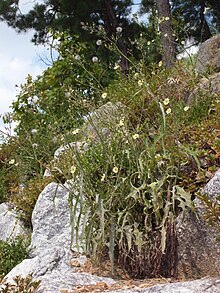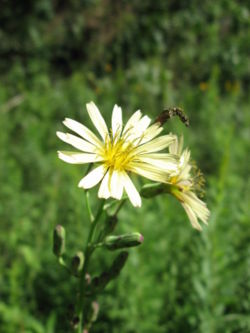fi
nimet breadcrumb-navigoinnissa


Locika indická (Lactuca indica) je listová zelenina pěstovaná v Číně, jižním Japonsku a v Indonésii. Varieta Lactuca indica var. laciniata se mimoto pěstuje i v Koreji a na Tchaj-wanu.[1] V angličtině bývá locika indická označována jako Indian lettuce. V jihovýchodní Asii se konzumuje hlavně jako zelenina, ale používá se i jako léčivá rostlina.
Locika indická je víceletá oboupohlavní rostlina, která je opylována hmyzem. Roste především na lehčích písčitých a hlinitopísčitých půdách. Vyžaduje dobře odvodněné, neutrální a zásadité (alkalické) půdy. Má raději nestíněné než polostíněné polohy.[2]
Locika indická (Lactuca indica) je listová zelenina pěstovaná v Číně, jižním Japonsku a v Indonésii. Varieta Lactuca indica var. laciniata se mimoto pěstuje i v Koreji a na Tchaj-wanu. V angličtině bývá locika indická označována jako Indian lettuce. V jihovýchodní Asii se konzumuje hlavně jako zelenina, ale používá se i jako léčivá rostlina.
Lactuca indica, the Indian lettuce, is a species of plant in the tribe Cichorieae within the family Asteraceae. It is native to western China (Xinjiang, Tibet), the Himalayas, and southwest Asia as far west as Turkey. It is widely introduced elsewhere, even as far as east Africa, and is thought to be an archaeophyte in Japan, brought in with rice cultivation.
Lactuca indica is a biennial herb, growing from a taproot to at least 40 cm tall and often reaching 2 m. Its flowers have white to pale yellow ray florets with yellower centers. The narrowness of the leaf blades and the degree of spikiness of leaf lobes varies greatly by region.

It is cultivated (or rather, its growth is encouraged) as fodder for rabbits, pigs, poultry and even fish in Asia.[2][3] Its young leaves can be, and are, consumed as a leaf vegetable in salads like other dandelions.[4] It is used in traditional medicines as an aid to digestion.
Lactuca indica, the Indian lettuce, is a species of plant in the tribe Cichorieae within the family Asteraceae. It is native to western China (Xinjiang, Tibet), the Himalayas, and southwest Asia as far west as Turkey. It is widely introduced elsewhere, even as far as east Africa, and is thought to be an archaeophyte in Japan, brought in with rice cultivation.
Lactuca indica is a biennial herb, growing from a taproot to at least 40 cm tall and often reaching 2 m. Its flowers have white to pale yellow ray florets with yellower centers. The narrowness of the leaf blades and the degree of spikiness of leaf lobes varies greatly by region.
 Lower leaves senescing during flowering, a trait typical to this species
Lower leaves senescing during flowering, a trait typical to this species It is cultivated (or rather, its growth is encouraged) as fodder for rabbits, pigs, poultry and even fish in Asia. Its young leaves can be, and are, consumed as a leaf vegetable in salads like other dandelions. It is used in traditional medicines as an aid to digestion.
Lactuca indica, conocida comúnmente como lechuga de la India, es una especie de planta fanerógama perteneciente a la familia Asteraceae.[1]
La lechuga de la India es una planta perenne erecta que alcanza una altura de 1.2 m. A veces es cultivada a causa de sus hojas comestibles en partes de Asia, especialmente en Malasia, Indonesia, Filipinas, Taiwán y Japón.[2]
Las hojas pueden ser consumidas crudas o cocidas, agregadas a ensaladas o sopas. Poseen un sabor levemente amargo. El tallo se consume cocido.
La planta es digestiva y tónica. Toda la planta posee una savia lechosa que fluye libremente de cualquier herida. La savia se endurece y se seca cuando está en contacto con el aire. La savia contiene 'lactucarium', que se usa en medicina por sus propiedades anodinas, antiespasmódicas, digestivas, diuréticas, hipnóticas, narcóticas y sedantes. Lactucarium tiene los efectos de un opio débil, pero sin su tendencia a causar trastornos digestivos, ni es adictiva.[3] [4][5][6]
Se ingiere para tratar el insomnio, la ansiedad, la neurosis, la hiperactividad en los niños, la tos seca, la tos ferina, el dolor reumático. También se puede utilizar una infusión de la planta con flores frescas o secas. La planta debe usarse con precaución y nunca sin la supervisión de un profesional capacitado. Incluso las dosis normales pueden causar somnolencia, mientras que el exceso causa inquietud y las sobredosis pueden causar la muerte por parálisis cardíaca. La savia también se ha aplicado externamente en el tratamiento de las verrugas.[7][8]
Lactuca indica, conocida comúnmente como lechuga de la India, es una especie de planta fanerógama perteneciente a la familia Asteraceae.
Bồ công anh hay rau bồ cóc, diếp hoang, diếp dại, mót mét, mũi mác, diếp trời, rau mũi cày (danh pháp hai phần: Lactuca indica) là một loài cây thân thảo thuộc họ Cúc (Asteraceae), sống một năm hoặc hai năm.
Thân không lông, cao 60–200 cm, thân thường đơn hoặc chẻ nhánh ở phần trên. Các lá phía dưới không lông, lá đơn mọc cách. Phiến lá thuôn dài hoặc dạng hình mũi mác, kích thước phiến lá dài từ 13–25 cm, rộng từ 1,5–11 cm, đầu lá nhọn, đuôi lá hình nêm hoặc men cuống, cuống lá thường ngắn hoặc men cuống tới tận nách lá. Mép lá nguyên hoặc xẻ thùy hoặc có răng cưa thô to. Mặt trên phiến lá màu xanh lục, mặt dưới xanh xám. Các lá mọc ở phía trên gần đỉnh ngọn sinh hoa thường trên nhỏ hơn và thẳng. Hoa mọc ở đầu ngọn, đầu cành. Hoa tự hình chùy, đầu cụm hoa rộng khoảng 2 cm; cuống dài 10–25 mm, mọc thẳng. Tổng bao hình trụ, kích thước chùm hoa thường cao 10–13 cm, rộng 5–6 mm, các lá bắc không lông, màu tía, các lá ngoài hình trứng, dài 2–3 mm, các lá trong hình trứng-mũi mác, các lá bắc tận trong cùng khoảng 8, hình mũi mác. Hoa tự thường có 21-27 bông, màu vàng nhạt, kích thước hoa 12–13 mm, rộng mm. Quả bế hình elip, phẳng, màu đen, kích thước quả dài 4-4,5 mm, rộng 2,3 mm; mỏ quả dài 1-1,5 mm. Mào lông màu trắng gắn liền quả dài 7–8 mm. Bồ công anh có số nhiễm sắc thể 2n = 18 (Peng & Hsu, 1978).
Bồ công anh chứa nhiều sắt (tương đương với lượng sắt tìm thấy trong rau dền),vitamin C, vitamin B vitamin A cao và nhiều nguyên tố vi lương khác như Magiê, canxi, natri…
Đông Nam Á, Ấn Độ, đông Siberi, Nhật Bản và miền nam Trung Quốc, Đài Loan, miền bắc Việt Nam. Thường mọc hoang dại ven đường, các sườn đồi nhiều nắng, ở cao độ từ thấp tới trung bình. Ít được trồng. Có hai dạng là indivisa (được trồng với lá thẳng-mũi mác, không xẻ thùy) và runcinata với lá thuôn dài, xẻ thùy sâu hình lông chim.
Tại Việt Nam, bồ công anh là một vị thuốc dân gian để chữa bệnh sưng vú, tắc tia sữa, mụn nhọt đang sưng mủ, hay bị mụn nhọt, đinh râu. Còn dùng uống trong chữa bệnh đau dạ dày, ăn uống kém tiêu.
Bồ công anh hay rau bồ cóc, diếp hoang, diếp dại, mót mét, mũi mác, diếp trời, rau mũi cày (danh pháp hai phần: Lactuca indica) là một loài cây thân thảo thuộc họ Cúc (Asteraceae), sống một năm hoặc hai năm.
翅果菊又名鵝仔草(学名:Pterocypsela indica)为菊科翅果菊属的植物。
二年生或多年生草本,根垂直直伸,生多数须根。茎常单生,上部多分枝,全部茎枝无毛。叶全缘或稍有细锯齿,线状长椭圆形,长椭圆形或倒披针状长椭圆形叶片。全部茎叶顶端长渐急尖或渐尖,基部契形渐狭,无柄,两面无毛。
头状花序果期卵球形,多数沿茎枝顶端排成伞房状圆锥花序。总苞长1.5cm,总苞片4层,外层卵形或长卵形,顶端急尖或钝,中内层长披针或线状披针形,顶端钝或圆形,全部苞片边缘染紫红色。舌状小花25枚,黄色。
黑色椭圆形瘦果,压扁,边缘有宽翅,顶端急尖或渐尖成喙,每面有1条细纵脉纹。花果期4-11月。
分布于日本、菲律宾、俄罗斯、印度、印度尼西亚以及中国大陆的海南、云南、浙江、江苏、四川、贵州、江西、北京、湖北、吉林、广东、安徽、陕西、西藏、湖南、河北等地,生长于海拔200米至1,800米的地区,一般生于山坡林缘、水沟边、林下、灌丛中、山谷、山坡草地和田间,目前尚未由人工引种栽培。
山莴苣,苦莴苣(江西),山马草(广东),野莴苣(海南植物志)
|access-date=中的日期值 (帮助)

Lactuca indica var. laciniata
Lactuca indica var. laciniata f. indivisa
Pterocypsera indica
Pterocypsera laciniata
アキノノゲシ(秋の野芥子、秋の野罌粟、学名: Lactuca indica)は、キク科アキノノゲシ属の一年草または二年草。
和名は、春に咲くノゲシに似て、秋に咲くことから付けられた[2]。
高さ50~200cm。大柄だが柔らかく、全体につやがない。はじめは根出葉をロゼット状に出すが、やがて茎をたて、花序を出す。
花期は8~12月。花は淡い黄色、直径2cmほどで舌状花だけでできている。種子はタンポポの綿毛を小さくしたような形をしている。
東南アジア原産で、日本全土・朝鮮・中国・台湾・東南アジアに分布。稲作と共に日本へ渡って来た史前帰化植物。
日当りの良い場所に生える。
アキノノゲシには葉に切れ込みがあるが、切れ込みのない細い葉を持つものは、ホソバアキノノゲシ(学名: Lactuca indica f. indivisa)という[2]。
왕고들빼기는 국화과의 한두해살이풀이다. 한국, 중국, 일본, 러시아, 동남아시아에 분포한다.
볕이 잘 드는 길가, 풀밭에서 흔히 자란다. 줄기는 높이 1-2m까지 자라며 곧게 선다. 뿌리에서 나는 잎은 꽃이 필 때 없어지며 줄기잎은 어긋나고 길이 10~30cm, 너비 1~5cm쯤 되는 긴 피침형이다. 깃 모양으로 깊게 갈라지며 뒷면은 흰색을 띤다. 꽃은 7~9월에 피고 길이 20-40cm쯤 되는 원추꽃차례에 많은 두화가 달린다. 두화는 혀꽃으로만 되어 있으며, 지름 2cm이고 연한 황색이다. 열매는 편형하면서 달걀 모양으로 검은색인 수과이다. 갓털은 흰색이다.
어린순을 나물로 무쳐 먹는다.